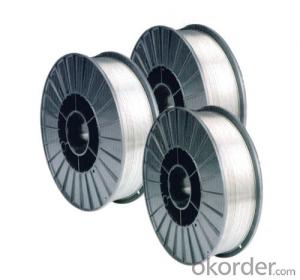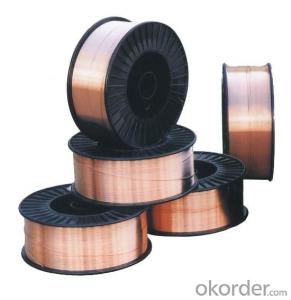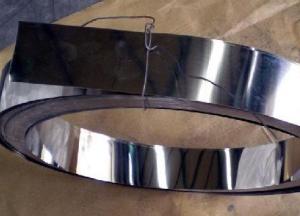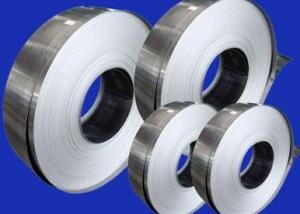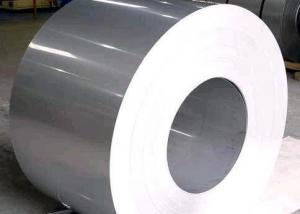AWS a5.18 er70s-6 co2 Gas Shileld Welding Wire
- Loading Port:
- Qingdao
- Payment Terms:
- TT or LC
- Min Order Qty:
- 10 m.t.
- Supply Capability:
- 1000 m.t./month
OKorder Service Pledge
OKorder Financial Service
You Might Also Like
AWS a5.18 er70s-6 co2 Gas Shileld Welding Wire
Main Structure:
aws a5.18 er70s-6 co2 welding wire
-Factory supply
-OEM packing
-0.8-1.6mm
-Spool drum pack, 10 days deliver
aws a5.18 er70s-6 co2 welding wire fil à souder
1. Brief Introduction:
aws a5.18 er70s-6 co2 welding wire fil à souder has excellent mechanical performance such as depositing speed and high efficiency, stable arc, little splash, good welding seam.
This series of welding wires are suitable for the low carbon steel and low alloy structure, vehicle, bridge, container, construction machinery, boilers and construction etc.have depositing speed and high efficiency, stable arc, little splash, good welding seam.
2. Advantages:
1. very low welding cost, high productivity and low electricity consumption.
2. excellent welding performance, stable arc, low spatter, easy slag removal.
3. perfect welding seam forming, small weld metal stomatal sensitivity.
4. easy operating, all position welding.
5. very low hydrogen content in the weld and lower nitrogen content, excellent crack-resistance.
6. little deformation after welding.
7. wide applicability. suitable for welding thin, medium and thick plates.
8. Suitably wide range of welding current.
3. Usage:
ER70S-6 Welding Wire for Low Carbon Steel Weld has been widely used in all kind of field. such as automotive industries, construction machinery production, shipbuilding, metallurgical equipment production, bridges, civil works, petrochemical industry, pressure vessels of boiler, locomotives, etc.
4. Size:
Wire Size | Spool Size | Package Size |
0.8mm 1.0mm | D100mm D200mm D300mm K300mm | 1kg 5kg 15kg 20kg 250kg 350kg |
5. Chemical Composition:
C | Mn | Si | S | P | Cu | Other | |
standard value | 0.06-0.15 | 1.40-1.85 | 0.80-1.15 | ≤0.035 | ≤ 0.025 | ≤ 0.50 | ≤ 0.50 |
sample value | 0.08 | 1.51 | 0.92 | 0.020 | 0.016 | 0.20 | 0.02 |
6. Typical Mechanical Properties of Deposited Metal:
Tenile strength δb (MPa) | Yield Point δ0.2(MPa) | Elongation δ5 (%) | AKV Impact Value (J) (-20°C) | Shielding Gas |
≥ 500 | ≥ 420 | ≥ 22 | ≥ 27 | 100%CO2 |
560 | 500 | 27 | 102 | 100%CO2 |
7. Diameter of Wire & Reference Current (DC+):
Diameter of wire (mm) | Ø0.8 | Ø 1.0 | Ø 1.2 | Ø 1.6 |
F current (A) | 40-180 | 50-220 | 80-350 | 170-550 |
V current (A) | 40-140 | 50-160 | 50-180 | |
OH current (A) | 40-120 | 50-160 | 45-180 |
8. Package:
1kg/ 5kg/ 15kg/ 20kg plastic spool
15kg/ 20kg metal spool
250kg/350kg drum
9.Picture:
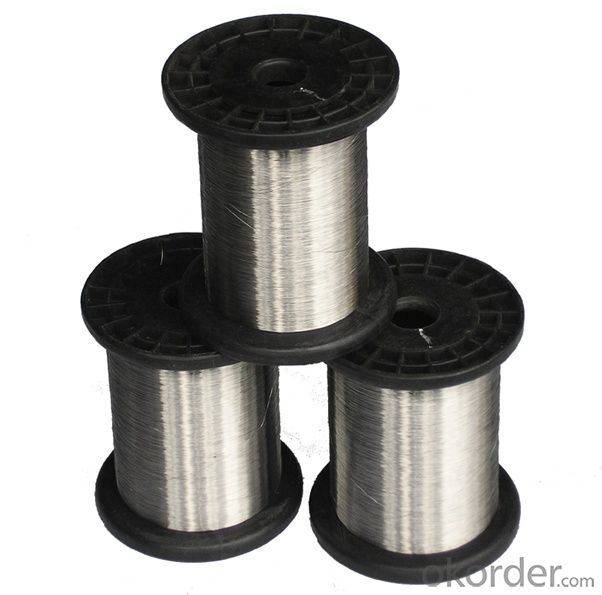
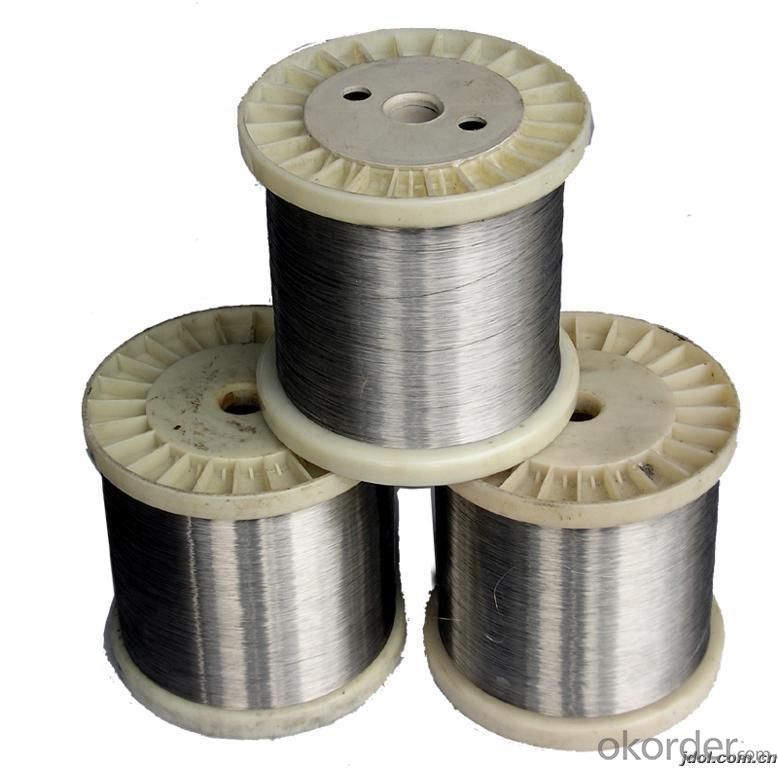
- Q:What are the different types of stainless steel wire electrodes?
- There are several different types of stainless steel wire electrodes that are commonly used in various welding applications. The specific type of stainless steel wire electrode to be used depends on the desired welding characteristics and the intended application. One of the most commonly used types is the ER308L stainless steel wire electrode. This electrode is designed for welding 18% chromium - 8% nickel stainless steels, such as types 301, 302, 304, and 305. It provides excellent resistance to corrosion and is suitable for welding similar or dissimilar stainless steels. Another popular type is the ER309L stainless steel wire electrode. This electrode is specifically designed for welding 300 series stainless steels to carbon or low alloy steels. It provides high strength and good resistance to cracking, making it suitable for applications where joining dissimilar metals is required. For applications involving high-temperature environments, the ER310 stainless steel wire electrode is commonly used. This electrode is designed for welding heat-resistant stainless steels such as types 310, 314, and 446. It offers excellent resistance to scaling and oxidation at elevated temperatures. In addition to the above, there are also stainless steel wire electrodes available for specialized applications. For example, the ER316L stainless steel wire electrode is specifically designed for welding molybdenum-bearing austenitic stainless steels, such as type 316. It provides superior corrosion resistance and is often used in the chemical and petrochemical industries. Overall, the different types of stainless steel wire electrodes offer a range of characteristics and properties that make them suitable for various welding applications. It is important to select the appropriate electrode based on the specific requirements of the project to ensure optimal results.
- Q:Is stainless steel wire resistant to UV rays?
- Yes, stainless steel wire is generally resistant to UV rays. Stainless steel is known for its corrosion resistance, and this extends to its ability to withstand the effects of UV rays. While prolonged exposure to direct sunlight may cause some discoloration or minor surface changes, stainless steel wire is unlikely to degrade or lose its structural integrity due to UV radiation. This makes it a suitable choice for outdoor applications, such as fencing, outdoor furniture, and architectural features, where it will be exposed to sunlight for extended periods. However, it's important to note that the specific grade and finish of stainless steel can affect its UV resistance, so it's always advisable to consult the manufacturer's recommendations for the best performance in outdoor environments.
- Q:Can stainless steel wire be used for springs in the automotive industry?
- Yes, stainless steel wire can be used for springs in the automotive industry. Stainless steel is known for its excellent corrosion resistance, high strength, and durability, making it an ideal material for automotive applications. Springs made from stainless steel wire can withstand the harsh conditions and environments typically encountered in the automotive industry, such as exposure to moisture, chemicals, and high temperatures. Additionally, stainless steel springs offer excellent fatigue resistance, ensuring long-lasting performance and reliability in automotive suspension systems, engine components, and other critical applications.
- Q:Is stainless steel wire suitable for conveyor belts?
- Yes, stainless steel wire is suitable for conveyor belts. Stainless steel wire is known for its high strength, durability, and corrosion resistance, making it an excellent choice for conveyor belt applications. It can withstand heavy loads, high temperatures, and harsh environments without rusting or deteriorating. Additionally, stainless steel wire is easy to clean and maintain, ensuring a hygienic and efficient conveyor system. Its versatility allows it to be used in various industries, such as food processing, pharmaceuticals, automotive, and mining. Overall, stainless steel wire provides a reliable and long-lasting solution for conveyor belts.
- Q:What is the tensile strength of stainless steel wire?
- The tensile strength of stainless steel wire can vary depending on the specific grade and diameter. However, on average, stainless steel wire typically has a tensile strength ranging from 500 to 2000 megapascals (MPa).
- Q:What kind of material is stainless steel drawing stainless steel? What are the main advantages and disadvantages?
- The advantages of the so-called oil grinding sand drawing sand is that the surface is more delicate, the visual effect is relatively better, better rust resistance, and other physical properties have not changed, the disadvantage is that the processing price is relatively high. If you do not require high selection of domestic grinding machine, because the water gas will rust. Stainless steel can also rust.
- Q:What are the different weaving patterns available for stainless steel wire mesh?
- There are several weaving patterns available for stainless steel wire mesh, including plain weave, twill weave, Dutch weave, and reverse Dutch weave. These patterns vary in terms of wire density, mesh opening size, and strength, allowing for different applications and levels of filtration.
- Q:What are the different types of stainless steel wire ropes used in telecommunications?
- There are several types of stainless steel wire ropes used in telecommunications, including 1x7, 1x19, and 7x7 constructions. These wire rope designs offer different strengths, flexibility, and durability to meet the specific needs of telecommunications applications.
- Q:Can stainless steel wire be used for making wire shelving?
- Yes, stainless steel wire can be used for making wire shelving.
- Q:What is stainless steel wire made from?
- Stainless steel wire is primarily made from a combination of iron, chromium, and nickel, along with other elements such as carbon and manganese.
1. Manufacturer Overview |
|
|---|---|
| Location | |
| Year Established | |
| Annual Output Value | |
| Main Markets | |
| Company Certifications | |
2. Manufacturer Certificates |
|
|---|---|
| a) Certification Name | |
| Range | |
| Reference | |
| Validity Period | |
3. Manufacturer Capability |
|
|---|---|
| a)Trade Capacity | |
| Nearest Port | |
| Export Percentage | |
| No.of Employees in Trade Department | |
| Language Spoken: | |
| b)Factory Information | |
| Factory Size: | |
| No. of Production Lines | |
| Contract Manufacturing | |
| Product Price Range | |
Send your message to us
AWS a5.18 er70s-6 co2 Gas Shileld Welding Wire
- Loading Port:
- Qingdao
- Payment Terms:
- TT or LC
- Min Order Qty:
- 10 m.t.
- Supply Capability:
- 1000 m.t./month
OKorder Service Pledge
OKorder Financial Service
Similar products
New products
Hot products
Related keywords
